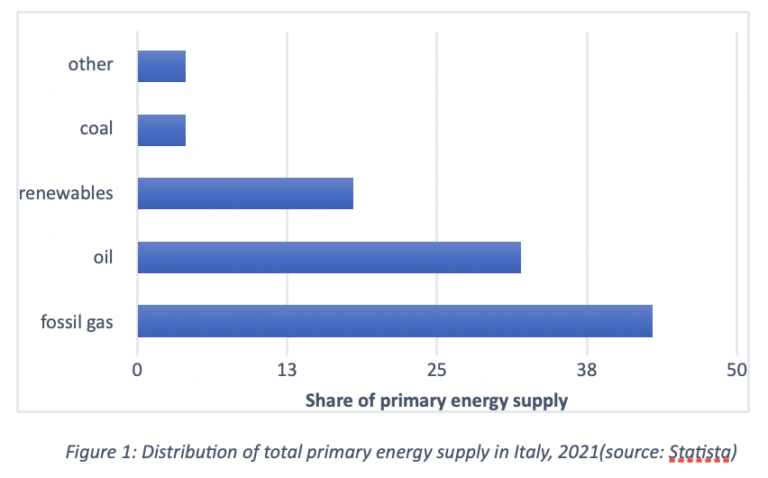Italy is the third-largest national economy in the European Union.
Italy’s per capita energy consumption is nearly 17 Percent lower than the EU average (2.5 toe in 2022). Electricity consumption per capita is around 5 000 kWh (5050 kWh in 2022), i.e., 9 Percent below the EU average. (1)
In 2021, fossil fuels accounted for 79 percent of the total primary energy supply in Italy. Among fossil fuels, natural gas ranked first, covering 43 percent of the energy mix. Oil followed at around 30 percent. On the contrary, renewables accounted for less than 20 percent of the total energy mix of Italy.(2)

Italy has proved to be a champion of emission cuts as it has consistently over the years achieved a steady trend towards decarbonization. Over the last 30 years, greenhouse gas emissions in Italy have decreased at a rate of 0.7 Percent per year, mostly due to the combined effect of strong development of renewable energy, increased energy efficiency, and the delocalization of industrial production. However, in order to achieve the “net zero” target by 2050, an acceleration is necessary and, together with private sector entrepreneurship, additional initiatives will need to be agreed. Estimates are that hydrogen could supply as much as 23 Percent of Italy’s total energy consumption by 2050, meaning almost a quarter of the entire energy demand. (3)
In a recent report by World Hydrogen Leaders in association with Renewables Now, by 2050, the demand for green hydrogen in Italy is likely to reach 9.5 million tonnes per year, driven by power generation with 3 million tonnes, the mobility industry with 2.6 million tonnes and the buildings sector with 2.1 million tonnes of hydrogen per year, according to SNAM’s study.
To date, hydrogen consumption in Italy is almost entirely limited to industrial use in refinery and chemical processes (e.g., ammonia) and is predominantly grey hydrogen. Hydrogen consumption in Italy is approximately 16 TWh, equal to 1% of overall national energy consumption (1,436 TWh) and corresponding to about 480,000 t/year, of which about 8,500 t/year are marketed in cylinders and special pipes.(4)
Italian gas group SNAM with the analytical support if McKinsey has conducted a study on the potential role of hydrogen and its infrastructure in the Italian energy system.
(5) The key findings of the report are:
In 2020 Italy launched a national hydrogen strategy to help decarbonize the economy in order to meet European climate targets. The Ministry of Economic Development said it was targeting investments in the sector of around USD12 billion by 2030, with half of the amount coming from European funds and private investments. The Government's plan to help boost production of green hydrogen, as stated in the draft document, is to introduce about 5 GW of electrolysers capacity over the 2021- 2030 period. The document also stated that by 2030, hydrogen could make up 2% of Italy's final energy demand and could help eliminate up to 8 million tons of CO2. The document also stated that the plans could create more than 200,000 jobs and generate up to 28.82 billion USD for Italy's gross domestic product, with hydrogen to be used in transportation, heavy industry, and natural gas pipelines. (6)
In November 2020, the MISE (Ministry for Business and Made in Italy) published the first “Guidelines for the National Hydrogen Strategy”, identifying the sectors in which green hydrogen is expected to become competitive in the short term. Moreover, the MISE has set up a hydrogen panel bringing together over 70 national stakeholders interested in the development and implementation of green hydrogen.
The MISE is also involved in the development of an “Important Project of Common European Interest”, looking at the hydrogen value strategic chain as part of industrial policy initiatives promoted by Italy, in cooperation with other EU Member States and the European Commission. (7)
Hydrogen was recognized by the Italian government as a renewable energy source in 2016, by the enactment of the Italian Legislative Decree No. 257 of 16 December 2016, which transposed the EU Directive 2014/94/EU concerning the deployment of alternative fuel infrastructures.
A further Ministerial Decree of 23 October 2018 removed a number of obstacles to the development of hydrogen in existing legislation, thanks to a joint commitment of several Ministries, the Italian Association for Hydrogen and Fuel Cells (H2IT) and various industrial players in Italy.
These new pieces of legislation have been much praised, as they have allowed a greater alignment of key technical conditions with other certifications and requirements (such as applicable ISO standards) and have eliminated existing limitations to the load pressure of hydrogen, which has enabled the deployment of hydrogen in, for example, the creation of hydrogen distributors for cars.

N/A